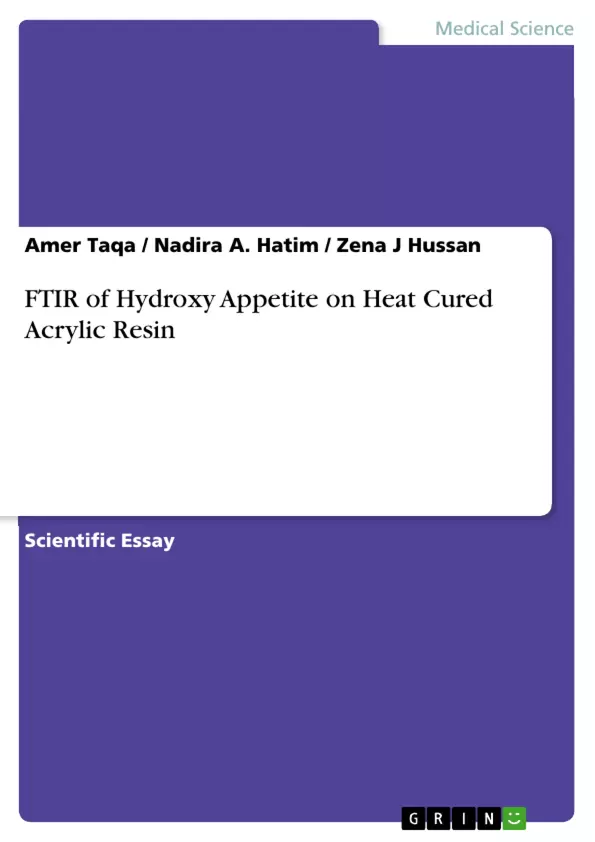Background and objective: To evaluate the FTIR of Hydroxyl apatite additives 2 %, and 5 % of dry (HAP) prepared from egg shells to the polymer. Materials and Methods: Thirty six specimens of heat cured acrylic resin and other specimens of heat cured acrylic resin with 2 % and or 5 % prepared then immersed in distilled water for 48 hours then dried for 42 hours then scratched with sharp knife and measured by FTIR spectra . conclusion: The result showed when adding 2% &/or 5% hydroxyl apatite to heat cured acrylic resin denture base material resulting a homogenous mixture, without chemical reaction in between and without changes of acrylic resin properties so, they can be used together in patients with bone hydroxyl apatite deficiency.
Inhaltsverzeichnis (Table of Contents)
- Introduction
- Materials and methods
- Result and Discussion
Zielsetzung und Themenschwerpunkte (Objectives and Key Themes)
The primary objective of this study was to evaluate the FTIR of Hydroxyl apatite (HAP) additives (2% and 5%) prepared from egg shells and added to heat cured acrylic resin. The research aims to determine if the addition of HAP alters the properties of the acrylic resin and whether it can be safely used in patients with bone hydroxyl apatite deficiency.
- Evaluation of FTIR spectra of heat cured acrylic resin with HAP additives.
- Assessment of the impact of HAP addition on the chemical structure and properties of acrylic resin.
- Determination of the potential applications of HAP-modified acrylic resin in dental prosthetics.
- Exploration of the biocompatibility and effectiveness of using HAP as a bone substitute material in dental procedures.
- Analysis of the suitability of HAP-modified acrylic resin for patients with bone hydroxyl apatite deficiency.
Zusammenfassung der Kapitel (Chapter Summaries)
- Introduction: This chapter provides a comprehensive overview of the background information regarding the polymerization of acrylic resin and the significance of the degree of conversion. It discusses factors influencing the degree of conversion, including the chemical structure of the monomer, polymerization conditions, and post-polymerization treatments. The chapter highlights the importance of FTIR analysis for characterizing biomaterials and addresses the challenges associated with traditional FTIR sampling techniques. It introduces photoacoustic sampling (PAS) as a solution for overcoming these challenges and emphasizes the significance of achieving high conversion for improved mechanical properties of acrylic resin.
- Materials and methods: This section details the materials and methods used in the study. It describes the synthesis of HAP from egg shells, outlining the chemical reaction involved and the importance of controlling pH and reactant concentrations. The chapter elaborates on the preparation of acrylic resin specimens, including the addition of HAP in different concentrations, followed by a detailed description of the FTIR analysis procedures. The protocol includes specimen preparation, sample powder grinding, and the use of potassium bromide for pellet formation. The study utilized a Tensor 27 FTIR spectrophotometer to obtain the FTIR spectra.
Schlüsselwörter (Keywords)
This study focuses on FTIR analysis, Hydroxyl Apatite (HAP), heat cured acrylic resin, biomaterials, dental prosthetics, bone hydroxyl apatite deficiency, and degree of conversion.
- Quote paper
- Amer Taqa (Author), Nadira A. Hatim (Author), Zena J Hussan (Author), 2012, FTIR of Hydroxy Appetite on Heat Cured Acrylic Resin, Munich, GRIN Verlag, https://www.grin.com/document/209692




